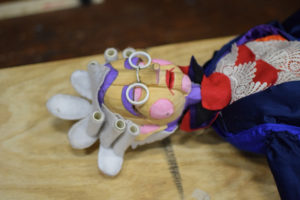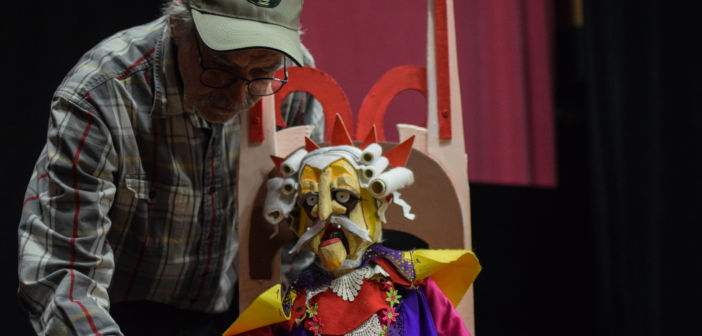Doug Roysdon swayed side to side with his arms flailing. Two of his actors stood, puppet in hand, watching as Roysdon spoke in a high-pitched German accent.
They were one week away from opening night and Roysdon wasn’t happy with the way they sounded. The movement of the puppet. Its voice. It wasn’t what Roysdon wanted.
He moved his body deliberately left and right emphasizing different points of the script with each turn.
“The people,” Roysdon said as he snapped his head to the left. “Of the court,” he said snapping to the right.
His puppet masters watched as Roysdon became the puppet.
Roysdon is the founder of the Mock Turtle Marionette Theatre based out of the historic Ice House on the North Side of Bethlehem. The Mock Turtle is a nonprofit children’s theater that uses puppets instead of actors in its plays.
Roysdon started the Mock Turtle in 1978, and he estimates the theater has done to close to 4,000 shows. His theater performed in the Kennedy Center in Washington, D.C., and Lincoln Center in New York City, every time using puppets as the focus.

The Storyteller lays on a table after a rehearsal Feb. 17, 2017, at the Ice House on the North Side of Bethlehem. Doug Roysdon handmakes every puppet used in a Mock Turtle Theatre production. (Erik Thomas/B&W Staff)
Roysdon chose to use puppets because he found it to be the perfect combination of his college majors. Roysdon was an English and art history major in college and said the two started to complement each other. He said one direction they can lead is puppetry.
“Because puppetry is the ultimate multidisciplinary thing,” Roysdon said. “It’s music, it’s theater, it’s literature, it’s visual arts, it’s 3-D arts, you name it.”
Roysdon makes all of his puppets by hand. He said the Mock Turtle is rare because it uses mostly marionettes, but also makes use of all types of puppets. His first step in building a puppet is sitting down and drawing. Roysdon said he has an idea of what the puppets should look like beforehand because he writes the scripts for the plays. He builds the base of the puppet in a two-week period but spends a lot of time working on the face.
“It just seems forever to get the puppet so it really works the way you want it to,” Roysdon said. “The way you want it to work and look the way you want it to look.”
Even one week before a performance, Roysdon finds himself tinkering with the puppets.
Roysdon said the puppets themselves decide how they ought to be controlled. The puppet will speak to the puppet master through its motions, telling him or her how it should be addressed. He said even though the puppets are made the same, they move in unique ways. The puppet master must build a relationship with the puppet to truly understand it.
Anna Russell, an assistant producer and actress for the Mock Turtle, said it is similar to mask work.
“When you do mask work, you look at the mask first,” Russell said. “And you look at the contours of the lines on the mask and the shapes it is making. The expression that it is holding because it is permanently frozen in one expression.”
Based off those observations, she can figure out what is and isn’t in that mask’s range. Russel said she will approach a puppet in the same way and make her face into the face of the puppet. She said that is where a puppet’s character comes from.
But puppet theaters can’t survive on their own anymore.
“Mock Turtle is also very immersed in arts and education,” Roysdon said. “If a puppet theater is going to survive, it usually has to piggyback with some other form, and Mock Turtle always piggybacks with education.”
Mock Turtle will go into local schools and link puppetry with the curriculum. Roysdon said they go in a classroom and have everyone make a puppet. The puppets are used to teach lessons on any subject matter. He said the key is to find ways to portray the puppets as the source of knowledge.
Russell said the work in schools is where the heart of the Mock Turtle is. She said Roysdon and the Mock Turtle are interested in programs that help the community grow. All the programs the theater is involved in are focused on mixing local artists and art with children and giving them a chance to express themselves.
“We find these kids, they often will express things with puppets that they would never say on their own or in real life,” Russell said.
Roysdon said increasing collaboration is the history of the Mock Turtle. The Mock Turtle works with other organizations to make it possible for artists to exist in the Lehigh Valley. One such program is the Ice House Tonight series, where the Mock Turtle, in cooperation with Touchstone Theatre, will bring in local artists and give them a stage to perform. The performances range from poetry and stand-up comedy to bands and youth theaters.
Russell said Ice House Tonight was started to make it possible for local artists to have an affordable place to do their art. The Mock Turtle wants to protect art and artists in the community and make sure they have a place to grow their art.
Sarah Atwood, an administrative assistant with the Mock Turtle, says the theater wants to create a sustainable arts culture in the Lehigh Valley, a culture that produces itself over time. Local members of the community would perform regularly instead of having big artists perform. Atwood said this benefits local artists and the community by offering a deeper cultural identity.
Roysdon said no one involved in Mock Turtle is trying to become a star. He said the theater wasn’t created to become rich and famous. The purpose behind the Mock Turtle is to give back to the art community in the Lehigh Valley and show that artists don’t have to leave to practice their art.






Comment policy
Comments posted to The Brown and White website are reviewed by a moderator before being approved. Incendiary speech or harassing language, including comments targeted at individuals, may be deemed unacceptable and not published. Spam and other soliciting will also be declined.
The Brown and White also reserves the right to not publish entirely anonymous comments.